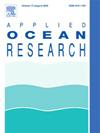美国东部和墨西哥湾沿岸的波科气候学
IF 4.4
2区 工程技术
Q1 ENGINEERING, OCEAN
引用次数: 0
摘要
海面的动态复杂性,以多个波浪系统同时存在为特征,需要在传统的整体波浪参数范围之外进行详细的分析,在多模态海洋的情况下,这些参数可能提供不准确的信息。这项研究利用光谱技术来确定波浪系统种群-称为波浪族-以便调查美国东部和墨西哥湾沿岸的波浪气候学。利用NOAA国家数据浮标中心的原位定向谱浮标测量数据,采用最大熵法构建了频率方向波谱。然后使用分水岭算法将波谱划分为波系,从而生成波谱分区的峰值能量密度的发生分布。每个浮标位置的发生分布被进一步划分,以确定主要的波族,每个波族都有独特的气象和地理来源。我们的分析显示,在不同的浮标位置和季节,波浪族特征(如波浪族显著波高、波浪周期和方向范围)存在显著的时空变化,从而突出了风发波的复杂性及其对海岸动力学的潜在影响。本文章由计算机程序翻译,如有差异,请以英文原文为准。
Wave family climatology of the U.S. East and Gulf Coasts
The dynamic complexity of the sea surface, characterized by the simultaneous presence of multiple wave systems, necessitates a detailed analysis beyond the scope of traditional integrated bulk wave parameters, which, in the case of multimodal seas, can provide inaccurate information. This research leverages spectral techniques to identify wave system populations - referred to as wave families - in order to investigate wave climatology along the U.S. East and Gulf coasts. Utilizing in-situ directional spectral buoy measurements from NOAA's National Data Buoy Center, the frequency-direction wave spectra are constructed using the maximum entropy method. The wave spectra are then partitioned into wave systems using the watershed algorithm, enabling the generation of the occurrence distribution of the spectral partitions’ peak energy density. The occurrence distribution at each buoy location is further partitioned to identify predominant wave families, each one with unique meteorological and geographical origins. Our analysis presents notable spatiotemporal variability in wave family characteristics, such as wave family significant wave height, wave period, and directional range, across different buoy locations and seasons, thus accentuating the complexity of wind-generated waves and their potential implications on coastal dynamics.
求助全文
通过发布文献求助,成功后即可免费获取论文全文。
去求助
来源期刊

Applied Ocean Research
地学-工程:大洋
CiteScore
8.70
自引率
7.00%
发文量
316
审稿时长
59 days
期刊介绍:
The aim of Applied Ocean Research is to encourage the submission of papers that advance the state of knowledge in a range of topics relevant to ocean engineering.
 求助内容:
求助内容: 应助结果提醒方式:
应助结果提醒方式:


